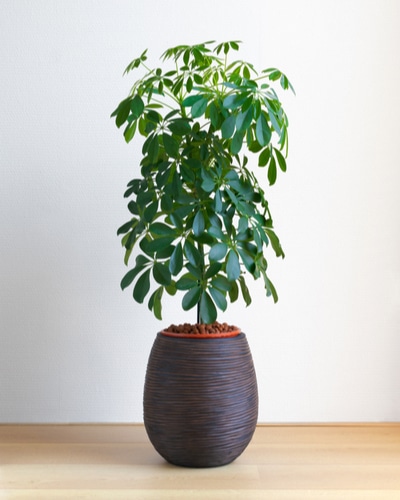Umbrella plants require the correct care, or they may drop their leaves as a stress reaction. Let’s look at why your Umbrella Plant is dropping its leaves and how to improve your plant’s health.
Umbrella Plants are popular tropical houseplants that are easy to care for and evergreen. They are fast-growing, and many people find their plants reach the ceiling with the proper care. These plants can also be kept compact by pruning if you don’t want such a large plant.
Why is my Umbrella Plant Dropping Leaves?
Umbrella Plant, also known as the Schefflera, are a beautiful tropical plant that thrives in warmer climates. While it’s natural for Umbrella Plants to drop the odd leaf, you have a problem if your plant starts to drop lots of leaves. An umbrella plant drops leaves due to incorrect conditions such as over or under watering, temperature changes, pests, or light issues.
1. Incorrect Watering
The most common reason that an umbrella plant will drop its leaves is due to incorrect watering. This includes over or underwatering your plant. Schefflera require moist soil to thrive and can also cope with drought-like conditions for a short time. However, you should remember that an umbrella plant isn’t a cactus and does need regular watering. If you’ve left your plant to dry out completely, this may have caused the leaves to drop. You can give the soil a good soaking to revive your plant and improve its health.
If you overwater your plant and make the soil soggy, your plant will suffer. Overwatering will cause root rot, and the leaves will turn black and fall off. Most plants don’t show symptoms of root rot until it’s too late and will eventually die.
Your umbrella plant should be watered regularly, and the amount of water will vary slightly depending on the climate you live in. You’ll find that your plant needs more water in the summer than the rest of the year. It’s recommended to water your umbrella plant when the top inch of soil has dried out.
Related: Jade Plant Dropping Leaves
2. Light Issues
Umbrella plants grow best in bright indirect sunlight. When grown in low light, the Scheffleras will drop leaves and become spindly. You can place your plant on a windowsill in the morning or late afternoon to allow it to get some extra light. Don’t leave your plant in full sun, or its leaves may become scorched.
3. Compact Soil
Another common cause of leaf dropping is due to heavy, compact soil. Umbrella plants require well-draining soil that is aerated and allows water, oxygen, and nutrients to reach the roots. Use a good quality house plant potting mix and consider adding some cactus soil or perlite to help with aeration. Sometimes an umbrella plant will drop its leaves after it’s been reported.
4. Cold Temperatures and Drafts
Umbrella plants are tropical and should be grown in temperatures of at least 50ºF and up to 80ºF. Cold weather will stress your plant and cause leaves to drop. It’s best not to leave your plant near a window in winter as it could be in a draft. Umbrella plants can also be grown outdoors in USDA Zones 9b to 12.
5. Fertilization Mistakes
Umbrella Plants don’t need much fertilizer, and when feeding your plant, it’s best to use a highly diluted dose of houseplant fertilizer. Some fertilizers cause salts and chemicals to build up in the soil, affecting your houseplant.
6. Low Humidity
Schefflera can cope with dry indoor air, but as they are, tropical plants do require some humidity. You can increase the air moisture surrounding your plants by using water trays and grouping several tropical plants.
7. Insect Infestations
Umbrella Plants are relevantly resistant to pests but can be affected by sap-sucking insects such as spider mites. An insect infestation will weaken your plant. Ensure that you regularly clean your plant’s leaves to protect it from insect infestation. If you notice any signs of pests, use horticultural oil or insecticidal spray to avoid infestation.
Fungal issues can be caused by misting, and leaf blight is common in humid areas. If you notice your plant has an infection, you can cut off and dispose of infected leaves.
Conclusion
Many things can cause an umbrella plant to drop its leaves. The bottom leaves are generally most affected and will be the first to discolor and drop off if there’s a problem.
It’s worth noting that dropped leaves don’t generally regrow in exactly the same place. This will change the plant’s appearance, so it’s worth working out what the problem is and making changes to avoid further leaf loss.
